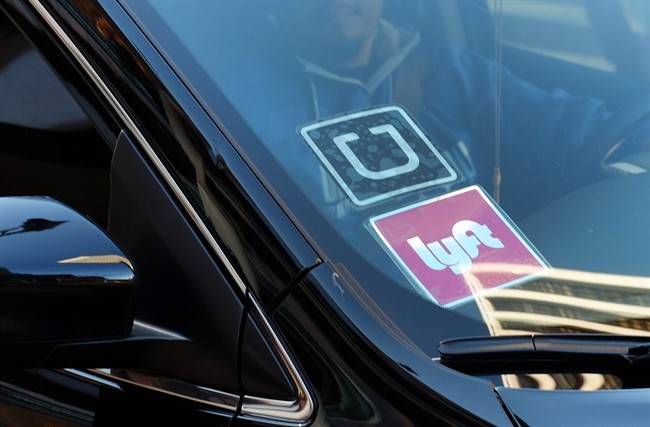Ride-hailing companies that want to operate in B.C. will have large operating areas and no limits on the size of their fleets, though they will not be allowed to charge any less than a comparable starting taxi fare, according to policies revealed Monday by the Passenger Transportation Board.
The board, which has jurisdiction over ride-hailing services — what it calls transportation network services or TNS in the province — said the limitless fleets and ability to operate beyond borders, which taxis are bound to respect, is part of the ride-hailing business model.
Board chairwoman Catharine Read said the boundaries need to be large enough for the business model to work, while their research suggests it will take years for companies such as Uber and Lyft to ramp up their fleet of vehicles and drivers, especially since B.C. requires operators to hold a Class 4 driver’s licence.
The board will also require ride-hailing firms to charge the same minimum rate as any taxi in the operating region.
In the Lower Mainland, that can range from $3.25 to $3.95. In Victoria, the three largest taxi firms charge a base rate of $3.30.
Read said the ride-hailing firms will be able to employ their dynamic pricing models.
“There is no cap on [ride-hailing] rates to allow them to increase prices to provide more drivers at peak times,” she said, adding passengers would be provided with an estimated cost for a trip up front.
There is also a requirement for ride-hailing operators to provide performance data from the day they start operating.
“The board will make evidence-based decisions based on data,” Read said, noting if there is evidence of congestion or other factors, it might affect future decisions on fleet sizes.
The board has set out five operating areas for the ride-hailing services: the Lower Mainland and Whistler, the capital region, the rest of Vancouver Island, Okanagan-Kootenay-Cariboo, and the rest of B.C.
The services can apply to operate in as many of those areas as they wish, though they will only be charged one application fee and one licence fee.
Taxi companies may also apply for a TNS licence, and when they are operating under it, the taxi would be subject to the same rules — including the flexibility to operate within defined ride-hailing boundaries.
Read conceded that taxi services are not happy with policies that allow ride-hailing companies to cross boundaries, but she said they would not consider changing taxi boundaries at this point because it would require extensive consultation.
Mohan Kang, president of the Victoria-based B.C. Taxi Association, said ride-hailing is the biggest challenge the industry has ever faced and predicted it will be tough for some operators to survive.
“You do not flood the market, nobody gains anything then,” he said. “If there is no cap on TNS, it defeats the purpose. Their drivers won’t be able to make a living and our drivers won’t be able to make a living.”
He argues the board should have considered doing a pilot project with a limited number of drivers.
“That way, with the passage of time, they would have a better idea. If they need more [drivers], then give them more. If they don’t, then at least the damage would only be to the extent that has been granted,” he said.
Kang said thousands of families rely on taxi income, and two or three times that rely on the industry’s spending on repairs, insurance and the ripple effect through the community.
“We are very concerned about this issue,” he said.
The Passenger Transportation Board will begin accepting applications from ride-hailing companies on Sept. 3.
Read estimates it will take between six and eight weeks before any application is approved.
Peter Lukomskyj, general manager of Lyft in B.C., said his company saw wins and losses in the policies laid out by the board Monday.
“We appreciate the Passenger Transportation Board’s decision to establish an innovative model that does not include municipal boundaries and caps at this time,” he said. “While we are disappointed that the regulations do not include a provincial boundary, we are pleased that large geographic regions were taken into account.”
He said Lyft intends to eventually operate throughout the province, but he believes the Class 4 commercial licensing requirement will make it difficult to do so outside the Lower Mainland.
“We are committed to B.C. and will continue to work with the [Passenger Transportation Board] and the province to create the conditions for us to bring Lyft to the Lower Mainland before the end of the year, and to more regions throughout B.C. in the future,” he said.



